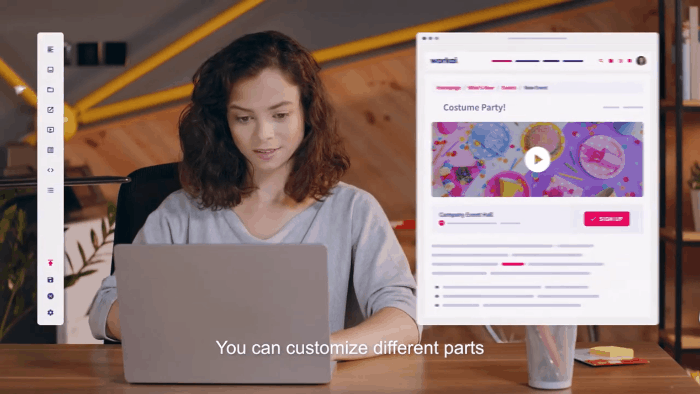

Intranet editorial team – how to set up and manage it?
Even more critical than the intranet’s features is the intranet’s content: engaging, personalized, unique, straightforward, and relevant to the current time and employees’ needs. Engaging intranet content ensures regular visits, performance, information flow, and better employee engagement.
As for PR content and all activities, companies perform to engage their customers, the internal communication should also reflect the same or even higher level of effort put into planning and executing content strategies. For that, an effective and agile intranet editorial team and relevant tools are needed.
Intranet editorial team – how to set up and manage it?
This article features the list of ready-to-use best practices on the effective intranet editorial team’s organization and management, helping you set up all needed resources for the new pandemic reality and the future growth – wherever it’s remote, hybrid, or onsite.
As you surely know – in the world troubled by the pandemic, internal communication has become an essential medium for maintaining high employee engagement and keeping the workforce informed and united. It can turn out to be challenging if teams switched to remote work.
Intranet editorial team – roles and tasks
We should start thinking about the intranet editorial team at the stage of designing and implementing the intranet. However, before we appoint editors, let’s think about the tasks related to their role. These are primarily:
- Taking care of Information Architecture
- Creating and publishing static content as well as taking care of its timeliness and relevance
- Creating and publishing time-relevant content
- Running internal cross-channel campaigns
- Measuring reach-out, content performance, KPIs, goals, and employee engagement
- Collecting feedback about content and its quality
- Supporting other departments (HR, IT, Sales) in the process of engaging employees and promoting important initiatives
To ensure the quality of the cooperation of the intranet editorial team and its results, we need to establish content management rules. The team must also have room for the main editor (usually a person from the internal communications team), who coordinates the work and ensures consistency of the content in terms of style and appearance.

Such a person helps editors determine what is worth publishing (what is needed from a business perspective, what is of interest to the audience) and give the content an appropriate structure. They often provide creative and editorial support.
They analyze with them statistics (e.g., number of visits to individual pages/news, number of unique users) and feedback (also periodically examines the intranet) to develop content that best meets the needs of business and preferences the employees.
Who should be part of the intranet editorial team?
In determining this, an excellent method, to begin with, is looking at the needs of employees and the company, i.e., finding out what categories of information employees need for work and practical cooperation.
Based on these answers, we can create a staff with specific communication needs and, based on them, identify the departments that can meet those communication needs and appoint editors from them.
Undoubtedly, this group will include corporate communication, HR, and IT. Marketing, process, and procedure management units, compliance, and security also play an essential role. The degree of involvement of operational business areas largely depends on the industry’s specificity and structure.
Here are just a few examples of the key personality traits a good intranet editorial team member could have:
- Knows well the nature of the department’s work,
- Can cooperate in distributed teams,
- Has a creative mind and good writing skills,
- Knows how to use new media like videos and podcasts to engage people,
- Is open to new ideas and is up to date with the latest internal comms trends,
- Acts as an expert or influencer.
It’s important because they are not always the authors of the content themselves – their tasks will require contact with specialists, experts, and validators. However, they do not need to have programming or advanced technology knowledge because current CMS tools are easy to use.

It may be difficult for these people to keep their content up to date because they have many other tasks. Where possible, it is worthwhile for them to have an editorial role included in their responsibilities.
How to prepare editors to perform their role effectively?
When our intranet editorial team is complete, the editors need training in using the intranet to use it efficiently and willingly in content management. However, this is not the only training that is worth planning. They will also benefit from workshops where they will develop their writing and editing content for the intranet, look at legal aspects related to, among others, image publication, use of photographs or sharing articles, and maybe preparing short films.
It will affect the quality of intranet pages and be an additional benefit – the benefit of being a member of the intranet editorial team. We can also think of a mini-motivational program to appreciate the most committed editors, such as additional points in the company’s cafeteria system or participation in a prestigious training/conference online.
In preparing the editors, they must develop a particular way of thinking about the content, i.e., they always remember the recipient and ask the question:
- “For whom is this information important?”
- “What is important in it?”
- “How to present it so that it is attractive and useful to the recipient?”
- “Is it worth publishing it?”
How does Workai help editors publish and manage relevant, interactive, and engaging intranet content?
Intranet editorial teams are usually small groups of highly committed people who need to provide instant and always relevant information to thousands working on the go and remotely, using various devices, having different work routines, and searching for all kinds of information needed to perform their daily tasks.
👉 Book a personalized demo to see how Workai makes internal comms teams more productive.
At Workai, we believe people should not be limited by complicated technology, but tools should support them in executing their internal comms strategies with more confidence and with better results. That’s why Workai’s comms-friendly drag-and-drop CMS allows people without any need for IT or graphic design skills to publish engaging and high-performing content using ready-made content-blocks and content-types.
With Workai, editors can finally run personalized internal campaigns, add any content and medium (news, banners, popups, newsletters, sliders, videos, podcasts, files, documents, and more), set the exact audience, and measure the impact with real-time analytics.
Workai also supports remote and distributed intranet editorial teams with collaboration features, like versioning, publication workflow and content approval, connected free stock image libraries, feedback channels, and various integrations – to streamline the process of intranet content lifecycle management.
We work closely with hundreds of enterprises to make sure that each feature fits perfectly into the internal editorial process – making it easy, convenient, but also fun to work with!

